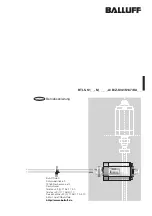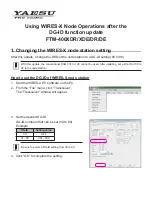
BTL5-S1_ _-M_ _ _ _A/B/Z-S32/S147/KA_ _
Micropulse Linear Transducer - Rod Style
3
english
2.1
Characteristics
Micropulse transducers feature:
–
High data security: Output data
are checked for validity and plau-
sibility in the µC.
–
Very high resolution, repeatability
and linearity
–
Measurement range monitoring
with "Out of Range" Bit 2
21
.
–
Immunity to shock, vibration,
and contamination
–
An absolute output signal
–
Wear- and maintenance-free
–
BTL to processor cable lengths
up to 400 m
–
Pressure rated to 600 bar
–
IP 67 per IEC 60529
2.2
Function
The transducer contains a tubular
waveguide enclosed by an outer
stainless steel rod. A magnet at-
tached to the moving member of
the machine or to the cylinder pis-
ton is moved over the rod and its
position constantly updated.
The magnet defines the measured
position on the waveguide. An inter-
nally generated INIT pulse interacts
with the magnetic field of the mag-
net to generate a magnetostrictive
torsional wave in the waveguide
which propagates at ultrasonic
speed.
The torsional wave arriving at the
end of the waveguide is absorbed in
the damping zone. The wave arriv-
ing at the beginning of the wave-
guide creates an electrical signal in
the coil surrounding the waveguide.
The corresponding value is output
as synchronous serial data (SSI) via
the RS 485/422 interface. This
takes place with high precision
and repeatability within the mea-
suring range indicated as the
nominal stroke length.
At the rod end is a damping zone,
within which no reliable signal is
available, but which may be entered
by the magnet.
The electrical connection between
the transducer, the processor/con-
troller and the power supply is via a
2
Function and Characteristics
cable, which depending on the
version is either fixed or con-
nected using a female connector.
Dimensions for installing the
Micropulse transducer:
➥
➥
➥
➥
➥
Fig. 3-1
Dimensions for installing the mag-
net:
➥
➥
➥
➥
➥
Fig. 3-4
2.3
SSI interface
The SSI interface uses 24 or 25
bits depending on the BTL model,
and the position values are sent in
Gray or binary code. The clock
frequency f is a function of the
cable length
➥
➥
➥
➥
➥
Table 2-1. For the
purposes of error detection bit 2
21
is provided as an “Out of Range”
message, see Fig. 2-1 and
Fig. 2-2. Sending of the position
values is finished within time t
m
. It
is started with the falling edge of
the last clock pulse. After this time
the BTL is ready for the next data
transmission.
1a
2
3
2
1b
~10 mm
~10 mm
Bit 2
21
Bit 2
0
... 2
20
t < t
m
t
v
= 150 ns
measured with 1 m cable
t
m
= 31 µs
independent of the clock
frequency
Fig. 2-1: Pulse diagram, example with 24 bit coding
➀
only for resolution > 5 µm
1
2
3
4
23
24
t
t
v
t
m
+Clk
+Data
MSB
Out of
Range
LSB
Clock sequence
Fig. 2-2: Output data shown with "Out of Range" situation
Position of magnet:
1) out of the measurement range
2) within the measurement range
3) magnet not present
"Out of Range" Bit 2
21
will be set
after the occurence of the event.
Value of the output data 2
0
... 2
20
:
1a) 0
1b) max. at end point + 10 mm
2) proportional to distance
3) 0
Technical data are valid within the
measurement range only, i.e. between
null and end point.
Null point
End point
➀













































